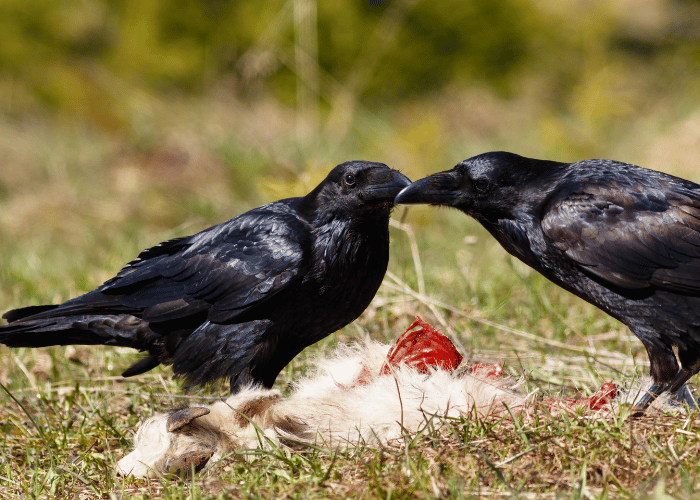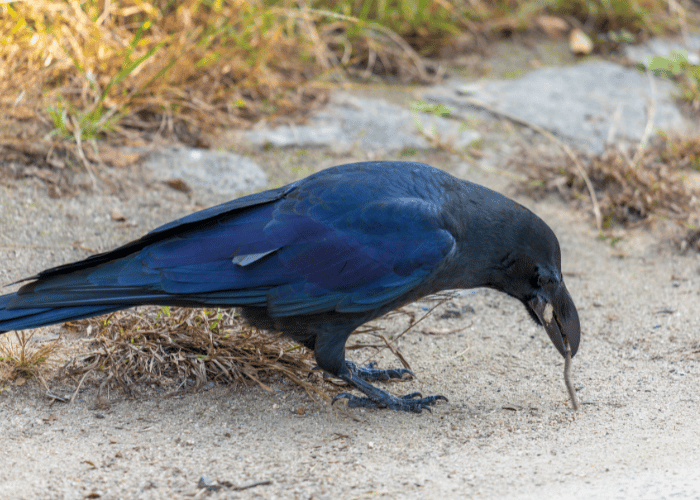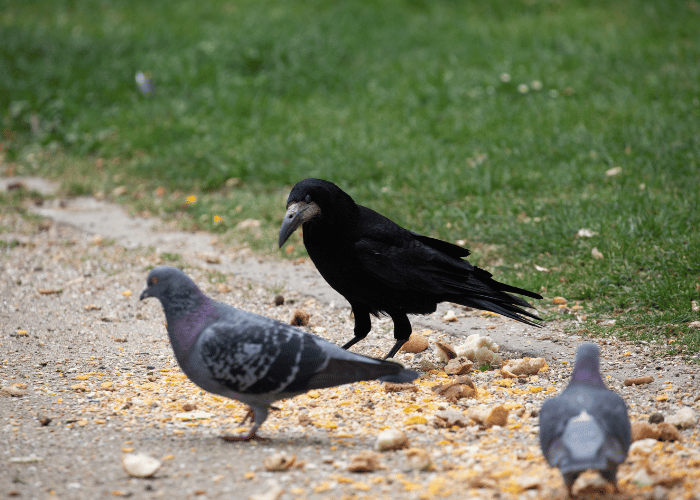What Do Ravens Eat
Table of Contents
Ever wondered, “What do ravens actually eat?” Well, I’ve got your answer, folks. Ravens, those shiny black birds that seem to have popped straight out of a mystery novel, are as interesting as they are ominous. The truth is, these intelligent birds have a hugely varied diet.
Now, ravens are what we call opportunistic feeders, which means they’ll eat practically anything their beaks can tear into. From insects, fruits, and small animals to the waste we humans leave behind, ravens aren’t picky eaters. They’re especially fond of carrion – that’s dead animal meat, if you’re wondering. Yep, it sounds a bit grim, but that’s life for these birds.
Our feathered friends have definitely mastered the art of survival with their flexible feeding habits. Still, if you’re like me, you’re probably thinking their dinner plate sounds like a bizarre hodgepodge! But what if I told ya it’s their well-rounded palate that’s led to their successful spread across various habitats around the world? Fascinating, right? Ravens are truly nature’s adepts when it comes to adapting!

Getting to Know Ravens
I must say, discovering the world of ravens can be a mixture of fascination and mystery. Now why, you might ask? Ravens, those large, black, intelligent birds you often see circling high in the sky, are among the smartest creatures in the animal kingdom! Yes, you read that right. Their cognitive abilities rival those of our chimpanzee buddies and even human toddlers.
Ravens are more than just shiny black birds with deep raspy croaks. Loaded with symbolism in various cultures across the globe, they have been part of folklore and literature. From Native American storytelling to Norse mythology and Edgar Allan Poe’s famous poem, the raven often enjoys a front row seat.
They belong to the Corvidae family, which includes other smart birds like crows, magpies, and jays. Crows are their closest relatives. And their average lifespan? It’s pretty impressive. Ravens often live up to 10 to 15 years in the wild and up to 40 years in captivity. Whoa! I know that’s mind-boggling!
Ravens are acknowledged as one of the most adaptable species in the world. Yes, they soar up high in the arctic tundras and even in the hot deserts of Arizona. It’s true! They have a rather cosmopolitan lifestyle, calling North America, Europe, Asia, and Africa, home.
Here’s a glimpse of their incredible facts:
| Fascinating Details | Numbers |
|---|---|
| Average lifespan in the wild | 10-15 years |
| Average lifespan in captivity | Up to 40 years |
| Species distribution | North America, Europe, Asia, Africa |
Now, are you wondering what these brainy birds nibble on? Well, hang on. In our next section, we delve into that much-awaited topic. Yes, we are about to talk about “what do ravens eat”! So come on, don’t lose track!
The Diet of a Raven: An Overview
Hey folks, I’m here today to talk about ravens. Specifically, let’s dive into what these feathered creatures tend to munch on!
Ravens, or if you’re the scientific type, ‘Corvus Corax’, are opportunistic omnivores. This means they’ll pretty much eat whatever they can get their beaks on. These crafty birds are known to dine on meat, insects, grains, fruits, small animals, and let’s not forget… garbage!
Ravens aren’t fussy when it comes to dead animals, either. They’re well known for scavenging carrion (that’s the body of a dead animal, for those not in the know). From roadkill to the remnants of a predator’s meal, if there’s meat involved, a raven isn’t going to turn its beak up at it!
In terms of plant food, ravens are just as flexible. They’ll consume a variety of grains and fruits. Whether it’s berries from a bush or corn from a field, if it’s edible, then it’s on a raven’s menu.
It’s fascinating how their diet varies depending on the season, too. In warmer months, you’ll find ravens snacking more on insects and small animals, while in winter, they lean more towards carrion and plant foods.
Just to give you an idea, here’s a simple breakdown of food types in a raven’s diet:
| Food Type | Example |
|---|---|
| Meat | Carrion and small live animals |
| Insects | Various bugs and beetles |
| Grains | Corn, wheat, and other field crops |
| Fruits | Berries, apples |
| Other | Trash, bird eggs, etc |
Their diet is a testament to their incredible adaptability, proving that these birds have what it takes to survive in a wide range of environments. Ravens are the epitome of survival.
So next time you spot a raven and wonder, “What the heck does that bird eat”, now you’ll know they eat just about anything they can find!

Understanding Raven’s Eating Habits
Ready to dive into the world of raven’s diet? Let’s go. The truth is, these smart birds are opportunistic feeders. You’ll find they eat just about anything, really. Offering a wealth of dining options takes a ton off of their to-scrounge-for list.
Now, speaking of specifics. A significant chunk of a raven’s menu is made up of invertebrates, fruits, and small rodents. Oh, and they do enjoy eggs and nestlings from other birds’ nests. Not the nicest dinner guests, I suppose. But, it’s nature and it’s all about survival, right? It’s not all sneaky snack attacks though. Ravens do make an effort. They’ll even tackle insects and spiders.
But it doesn’t end there. Nope. These adaptable characters can switch up their diet in a flash depending on the climate, season, and location. You may see them munching on the occasional reptile or amphibian. And, believe it or not, they’re not above scavenging. It’s not unusual to spot them enjoying leftover carrion or human waste.
Now, you must be thinking, “what about plants?” You’re right. Ravens supplement their diets with a variety of vegetation. We’re talking wild berries, grains, nuts, and more.
Here’s a handy little rundown for ya:
| Primary Food Source | Additional Sources |
|---|---|
| Invertebrates | Reptiles & Amphibians |
| Fruits | Carrion & Human Waste |
| Small rodents | Berries, Grains, & Nuts |
| Eggs/Nestlings |
Now, I’ve seen ravens, and perhaps you have too, tugging at roadkill or teasing predators for a share. Why’s that? Well, ravens have been known to work in pairs or small groups to source food. They’ll even use their intelligence to access food in tricky places. Yeah, you heard that right. They’re even known to drop hard-shelled nuts onto roadways and wait for cars to crack them open. How’s that for an early bird breakfast? Clever, right?
So, there you have it. It’s not just caw-caw-caw with these black-feathered buddies. There’s a whole lot happening behind the scenes. Their diet is as eclectic as it gets. Making it in the wild, ravens seem to have figured it out. What’s on your menu tonight? They might just have some ideas!
The Impact of Human Activity on Raven’s Diet
Well, who would’ve thought that I’d be rolling up my sleeves to chat about what human activity means for our black-feathered friends, the ravens. But here I am, and here we go!
Now, you might know that our activities have some serious knock-on effects on wildlife, right? Well, ol’ Corvus Corax – that’s the scientific name for ravens – isn’t an exception. In fact, they’ve adapted their diet quite a bit thanks to us humans.
Ravens are omnivores, which means they munch on both plants and meat. But with the rise in human population and activity, they’ve found a bonus in the leftovers we tend to leave behind. Garbage cans, landfills, picnic spots, you name it, ravens are there for a quick bite.
While the phrase, “A raven’s gotta eat what a raven’s gotta eat” seems fitting here, the food we leave behind isn’t always the best, you know? Lots of processed foods, sugars, salts – not the healthiest of diets, I’d say.
Here’s something interesting, a quick look at some numbers will show just how dependent ravens have become on us.
| Food Source | Estimated % of Diet |
|---|---|
| Natural | 40% |
| Human-related | 60% |
Quite frankly, it’s clear as day that the impact of human activity is hard to ignore when it comes to the raven’s diet.
While it’s a win-win situation for ravens in certain ways – they get easy access to a wide buffet range whenever they fancy – there’s a downside. What’s good for the raven isn’t always good for the rest of the ecosystem.
Why so? Well, because ravens can also turn nasty and take down smaller birds and their nests. Increased populations of ravens (thanks again to human-related food sources) could spell trouble for the little fellas in the bird world.
I guess it’s a line we’ve heard before – our actions have consequences, sometimes ones that weren’t so obvious at first. Keep that in mind the next time you see a raven hovering over a garbage can.
The Link Between Ravens’ Diet and Their Habitat
You know, it’s fascinating how an animal’s habitat can directly influence its diet. Take our friends, the ravens, for instance. These intelligent birds adapt their menu based on what their environment offers.
Ravens are widely distributed across the globe and live in varied habitats including forests, tundra, deserts, mountains, and even human settlements. Their diet, quite unsurprisingly, varies greatly upon where they make their homes. Desert-dwelling ravens, for example, would snack on insects, while those found in forests or mountains might prefer larger prey, like small mammals or reptiles. And let’s not forget that ravens are scavengers, so carcasses make a large chunk of their diet, too.
Here’s a simplified snapshot of a raven’s diet based on their habitat:
| Habitat | Primary Diet |
|---|---|
| Forests | Small mammals, insects, berries, carrion |
| Deserts | Reptiles, insects, carrion |
| Mountains | Rodents, carrion |
| Tundra | Carrion, rodents, bird eggs |
| Human settlements | Human food waste, carrion |
Ravens inhabiting human settlements often have the most diverse palate. These highly adaptable birds make the most of what’s available, munching on everything from our trash to pets’ food to roadkill.
While we’re on the subject, it’s worth mentioning that these birds do love to pilfer from other animals’ meals. Think of them as the pirates of the animal kingdom! They’ve been known to steal food from not only smaller birds but sometimes even from larger predatory birds. Clever, eh?
So, there you have it. A raven’s diet isn’t some ‘one-menu-fits-all’ deal. In fact, it’s a vibrant collage of the surroundings they inhabit. This variety doesn’t just showcase the raven’s dietary adaptability but is also a testament to their survival skills in a range of ecosystems.

Final Thoughts on What Ravens Eat
Well, we’ve made it to the finish line! After traversing through the dining habits of the raven, I can confidently say, it’s a wild journey. Who knew these glossy black birds had such a diverse menu?
There are a few key points I want to wrap up with, just to make sure the image of a raven munching on all sorts of things is really etched in there.
- Ravens aren’t fussy eaters. From insects in the grass to fruits on trees, and leftovers of a wolf kill, they’ll eat pretty much anything.
- They’re smart and adaptable. Is it cold and food is scarce? Don’t worry, they’ll raid a trash can or pluck a fish from sea holes.
- Their diet changes with the seasons. It’s like they have a food calendar, rotating from one delicacy to another as the earth makes its trip around the sun.
Remember, while it’s fun knowing what ravens eat, avoid feeding them. We’ve got to ensure these intelligent birds maintain their natural diet and eating habits. So, let’s appreciate them from a distance as they go about foraging and scavenging in their unique, raven-like way.
And there it is. What ravens eat—in all its diverse, surprising, and a little bit gross glory. Not sure why, but I’m feeling peckish. Maybe some carrion… or better yet, leftovers will do!






